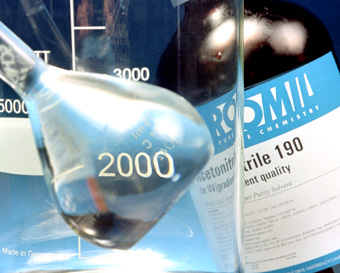 The Analytical Grade for the Third Millennium
The Analytical Grade for the Third Millennium
It is easy to understand why the vast majority of chemical experiments are conducted in the liquid phase. Solids rarely react together and gases are too difficult to contain. This is especially true of analytical chemistry where the analyte to be measured is first processed into a more manageable and convenient form - a solution - before being presented to the measurement process. This process can be as simple as a manual titration or as complicated as a modern hyphenated separation-detection technique.
Modern analytical chemistry makes extensive use of sophisticated instrumentation. For analysis at the parts per billion level, this usually is the only choice. However, for such instrumentation to perform consistently and reliably the analyst should choose their solvent system very carefully.
Often the solvent is the key factor in obtaining a valid analytical measurement. Solvent effects such as polarity and dipole moment can affect how the analyte can be brought into solution in the first place. Properties such as boiling point and melting point can determine the ease with which the analyte solution can be handled. And the purity of the solvent can be a critical factor in detecting and measuring the analyte because solvent impurities can either mask the analyte peak as in chromatography, or suppress its presence by poor transparency as in ultra-violet or infra-red spectrometry.
Many suppliers of laboratory chemicals have responded by supplying higher purity solvents and reagents specifically branded for a particular instrumental technique. The now ubiquitous 'HPLC solvent' or 'spectroscopy solvent' are typical examples. And this because their own so-called 'analytical grade' products are just not good enough for modern analysis! This is because, generally, most laboratory suppliers are no more than that. That is, they supply laboratory chemicals; they don't manufacture them. The chemicals themselves are actually manufactured by the global chemical industry. The laboratory suppliers buy from these sources, perhaps test for suitability, then package into smaller containers and offer to the laboratory user. With the laboratory sector accounting for an insignificant fraction of their output, it is clear that the multi-national manufacturers are just not interested in producing chemicals with the laboratory user in mind. When their production plants must be cleaned out or spent catalyst replaced, the negative effect on the product quality is not noticed by their industrial customers. But, this can have a profound influence on the quality of such solvent when used in the laboratory.
ROMIL‑SpS™ Super Purity Solvents have long addressed this problem. By taking the solvent output from prime global sources and purifying it by chemical treatment and glass distillation we both remove this inconsistent quality as well as making a vast improvement to the purity (or, to look at it another way, a vast reduction in impurities). This means that the laboratory user can take advantage not only of the consistent quality of ROMIL‑SpS™, but also its suitability for a wide range of applications. And since one grade only need be stocked for a variety of methods, ROMIL‑SpS™ products also have the benefit of assisting laboratories, not only in their compliance with health, safety and environmental legislation, but also in their quality system accreditation to international standards such as ISO 9000 and ISO 17025. They truly are to be considered the de facto analytical grade for laboratories in the third millennium.